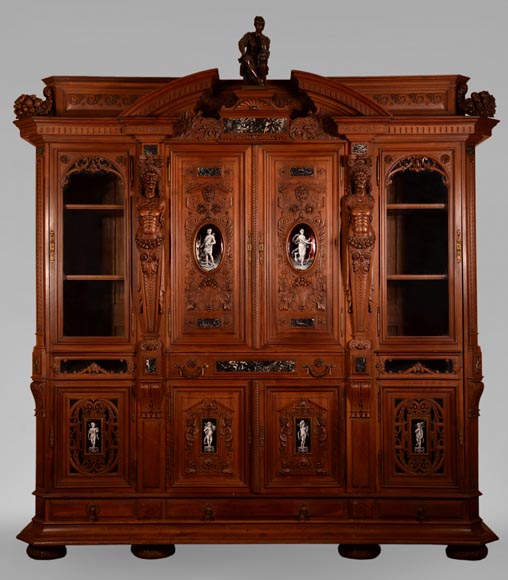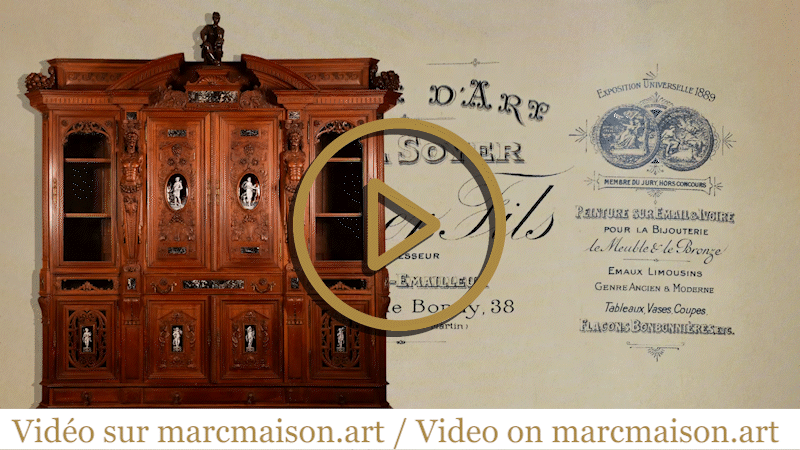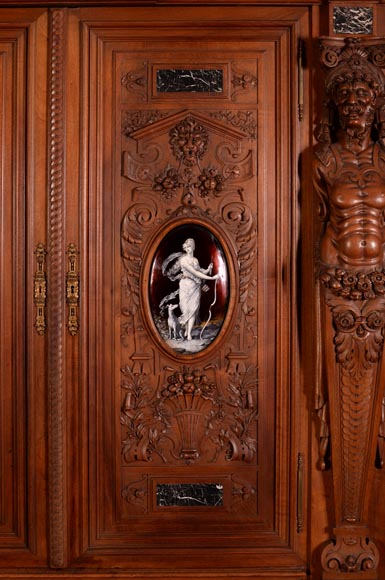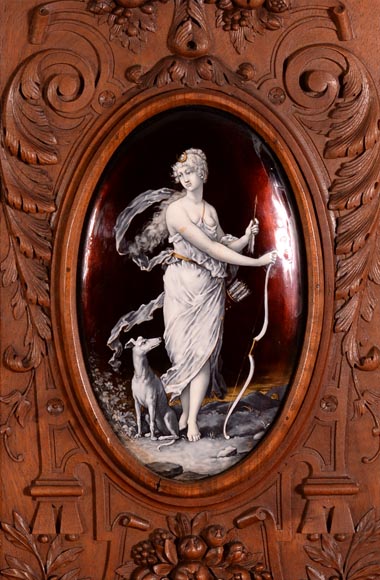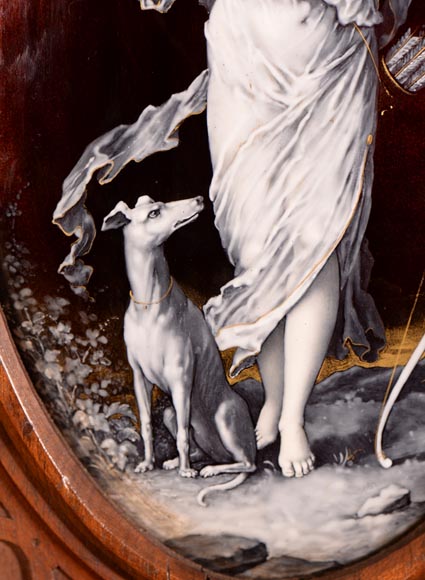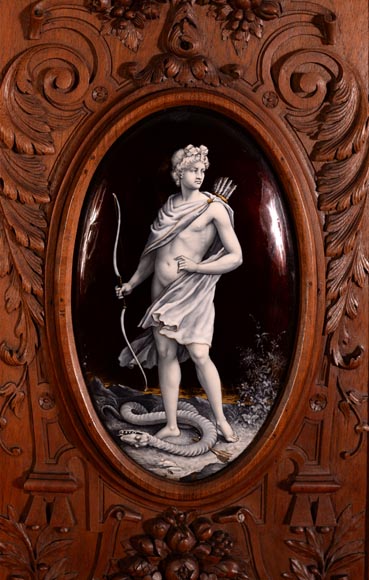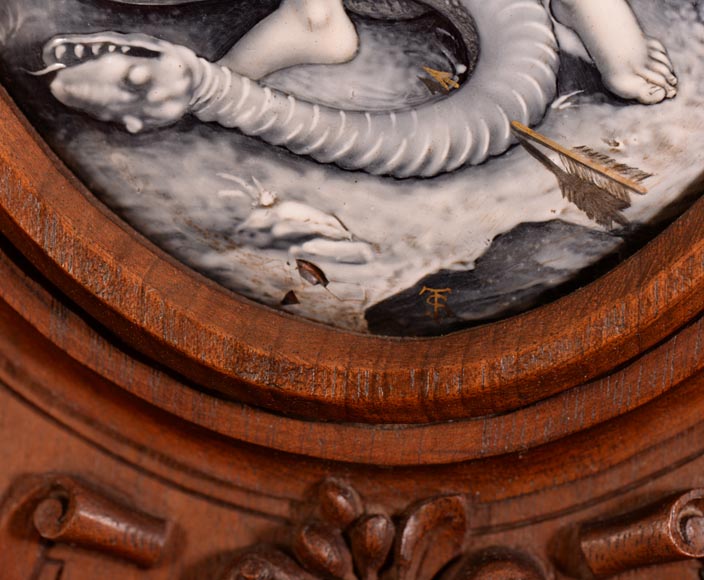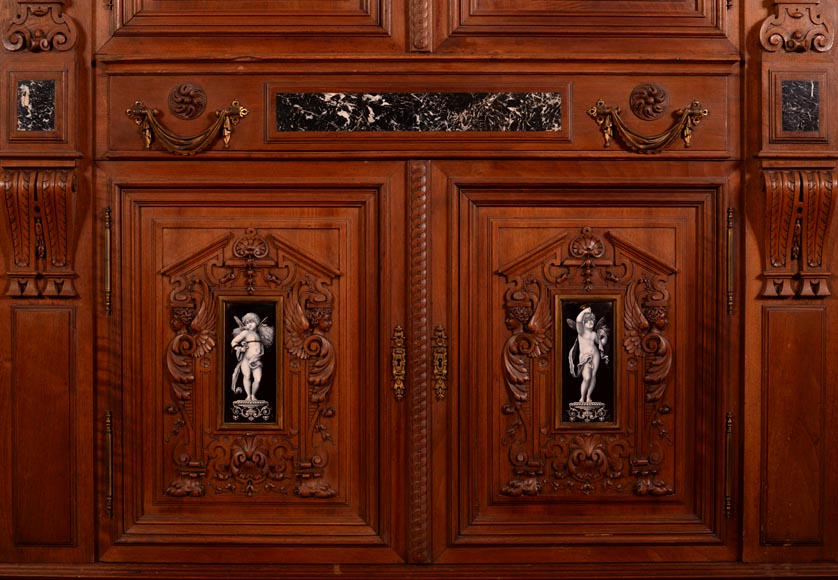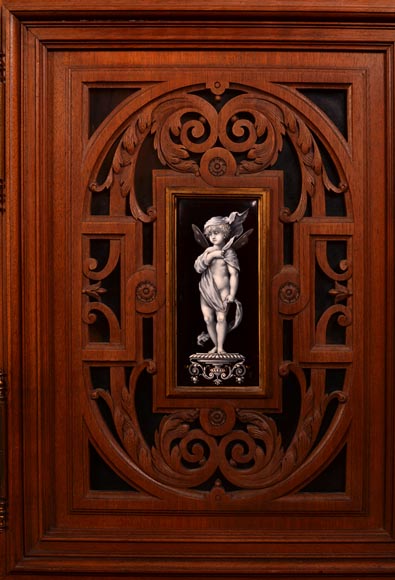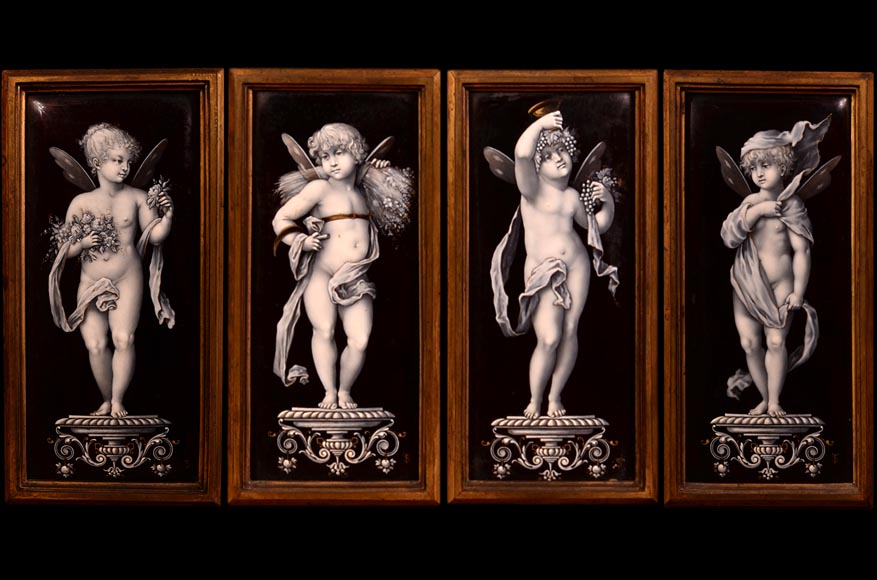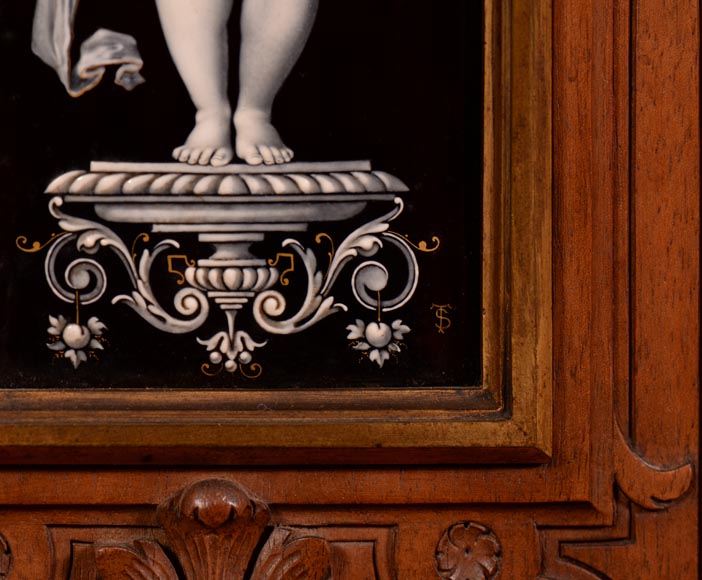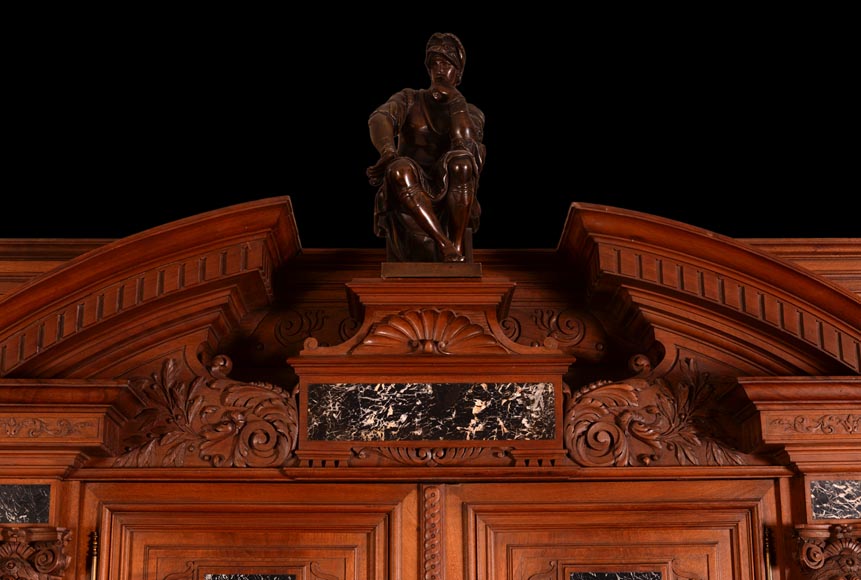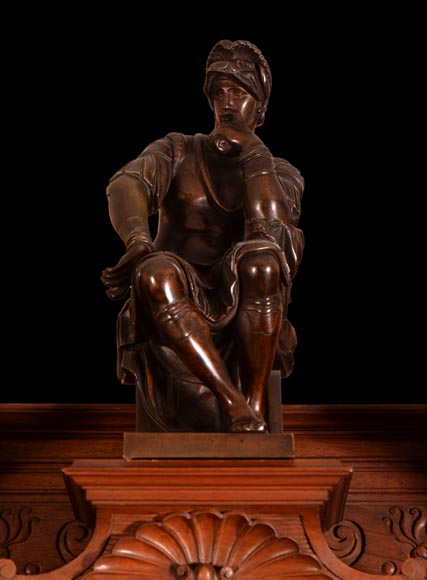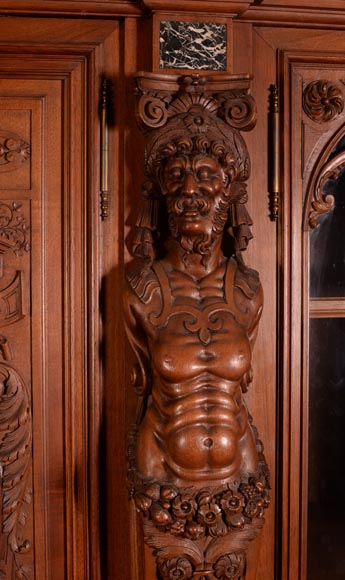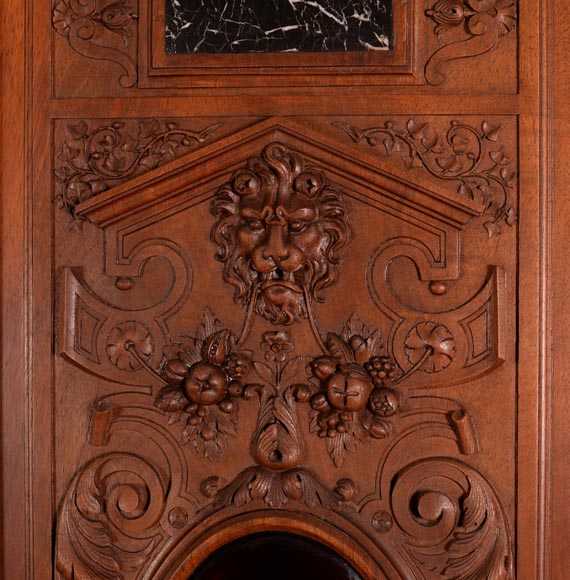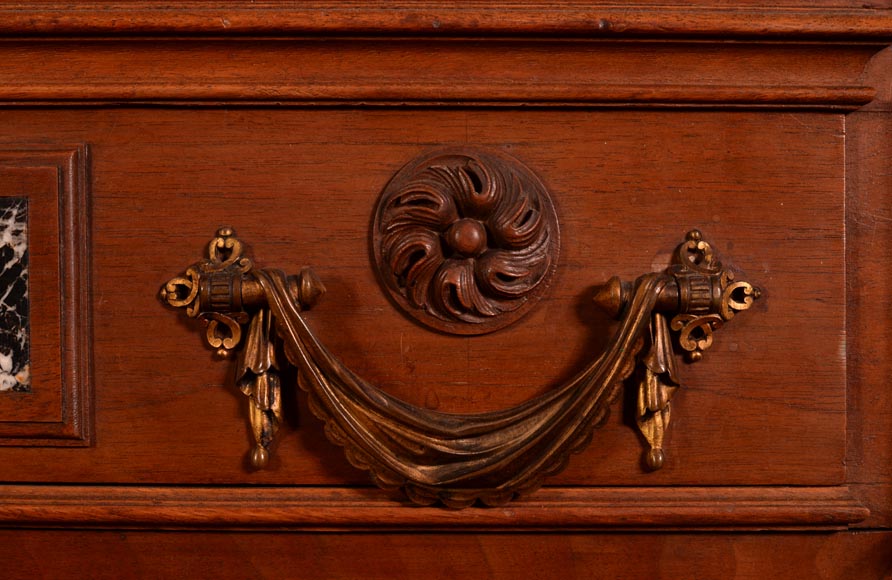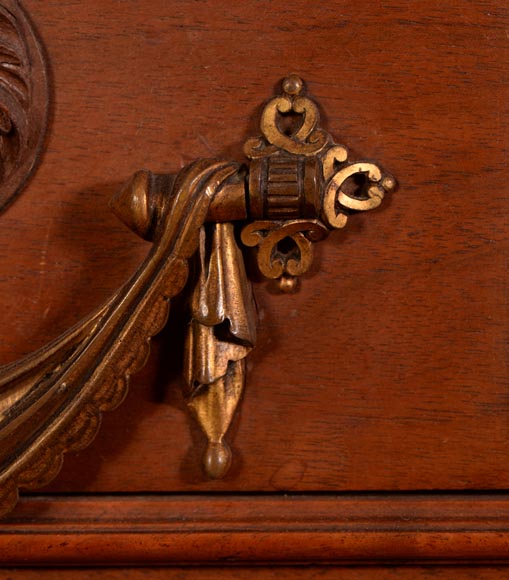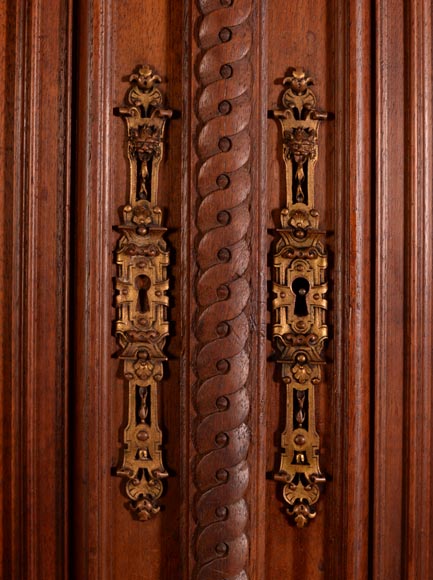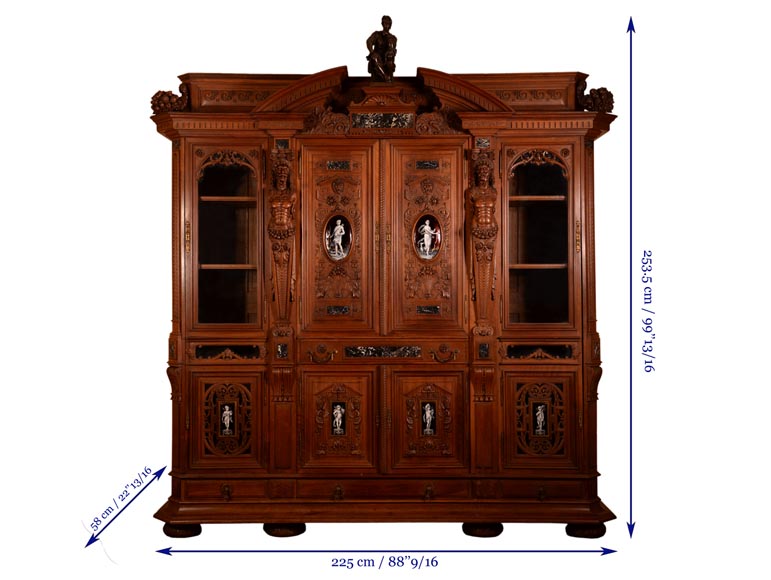Style Neo-Renaissance / Ref.10911
Large Neo-Renaissance style walnut cabinet - Painted enamels signed by Theophile Soyer (1853-1940)
Dimensions
Width 88'' ⅝ 225cm
Height 100'' 254cm
Depth: 22'' ⅞ 58cm
This two-bodies Neo-Renaissance style display cabinet with two glass doors was made in the second half of the nineteenth century in waxed walnut. The enamel plates, remarkable in their execution, are signed with the initials of Theophile Soyer (1853-1940), great enameler of the second half of the 19th century. Enamels in black and white hues, which suggest an early work as they are far different from the better-known production of Theophile Soyer, as well as the cabinet making work, allow to date it more precisely from the years 1875- 1880.
In the middle of the cabinet, on the main panels, two oval bulging medallions represent on one side “Apollo slaying the Python”, on the other “Diana the Huntress”. Apollo, a quiver on his back, arrow in the hand and with a triumphant glare, spans a dead snake on the ground, while Diana is represented with her traditional attributes: a quiver and a dog at her side, the goddess with knotted hair and uncovered breast is preparing, with a certain nonchalance, to loose an arrow. The two medallions are set in carved frames adorned with bouquets of flowers, lions and friezes of pearls.
On the doors of the lower cupboards, four panels adorned with rectangular enamel plates, also signed Theophile Soyer, represent the seasons incarnated by putti. While spring is symbolized by the rebirth of Flora, summer prepares winter by the harvesting of ears of wheat. Autumn is the season of grape harvest: the putto holds in one of his hands the fruits of his crop and in the other a cup that will host the drink. In winter, the putto is covered with a drapery moving in the fresh air of the wind. The enamels are made with great virtuosity and adds to this piece of furniture a great preciousness. The square and rectangular Black Marquina marble pieces that decorate this work are echoed by the enamels they only enhance. These enamels are indeed of a great brilliance and their figures of a brilliant whiteness contrast with the black background. The gold-colored elements, such as the quivers of the God and the Goddess, enhance the whole.
The furniture is capped with an architected broken pediment whose cut sides are adorned with cornucopias from which spread pomgranates. In the center, on a pedestal, stands a bronze statue made by the Barbedienne foundry representing Lorenzo II de Medici, Duke of Urbino (1492-1519), sitting and thoughtful. It is a representation of the statue decorating the tomb of the latter made by Michelangelo in the sixteenth century inside the Medici Chapels in Florence. This statue will have a great fortune in the nineteenth century through many editions.
On either side of the central cupboard, two faun-looking Atlants were carved with great finesse and great attention to detail. Their bust, depicting the features of an aging body, rests on a pedestal and their bearded face is capped with an oriental-inspired turban. These two enigmatic and mysterious figures are typical of the Neo-Renaissance style and the very nineteen-ish taste for curiosities.
In addition to bronzes, marble and enamels, it is remarkable to note the lavishness of the carved ornamental repertoire such as the curves and laurel branches on the pediment, the lion heads and baskets of fruits on the central doors, the few naturalist rosettes or even foliage carved around enamel plates with putti. The lavish decor of this furniture reflects a taste for detail that goes hand in hand with the Neo-Renaissance style, appeared in the 1830s in a context of rediscovering history and past styles. The cabinetmaking work of this firm, which can be said to be a Parisian work, is in fact characteristic of workshops production of the period specialized in the Neo-Renaissance style such as the Grohé brothers or the Damon, Namur et Cie house, such as this Neo-Renaissance style credenza carved in natural walnut on display at the 1878 World Fair. Like the one we present here, this credenza is composed of two glazed bodies making a library and connected by a chest opening with two doors. The furniture is also surmounted by a pediment where, between the arches, a pedestal is decorated with a bronze work of art reproducing the famous statue of Lorenzo II de Medici. Founded in 1840 by Antoine Krieger, then sold to M. Recault before being taken over by Damon, Namur et Cie, this house quickly acquired a certain importance and imposed itself on the French and European markets.
The locks are marked “Huby fils serrurier Paris” (“Huby son locksmith Paris”). Auguste Luchet calls him in his account of the 1867 World Fair the “young prince of the locksmiths” and his Renaissance-style creations were famous.
Our piece of furniture takes its decor and theme in the Renaissance but also its technique. Painted enamel and carved wood are among the techniques that artists intend to put back into fashion, both by challenge and by the desire to perpetuate traditional and artisanal skills in a nineteenth century marked by industrialization and development. Painted enamel, which developed in Limoges from 1530 to the beginning of the 17th century, belongs in fact to the crafts of the Renaissance, until its consecration in the second half of the century, time of pastiches of all kinds. Reappeared around 1840, painted enamels were thus, from the 1860s, practiced by many artists. Among them, Paul Soyer, sculptor by profession and father of Theophile, was the collaborator, since 1863, of Claudius Popelin (1825-1892), painter and enameller thanks to whom the enamel painted “in the manner of Limoges” found a prominent place. Paul Soyer later created his own studio which enjoyed a certain success thanks to the decorations he created to adorn furniture and objects and specialized in enamel painted white figures on a black background like the enamels of the Renaissance. With this piece of furniture, Theophile Soyer, who will later be one of the great enamellers of the Art Nouveau style with a production in bright and shimmering colors, seems to be in line with the paternal style, at a time when he is still his collaborator. The work of this piece of furniture is therefore the fruit of a youthful work, which sets it apart from the usual production of Theophile Soyer.
Born in 1853 in Paris and died in 1940, Théophile Soyer began with his father who, according to Michel Dillange, was “more of a craftsman than an artist”, which led him to push his son to follow Fine Arts lessons in order to be the creator of ever more artistic compositions. After this training, where he learns the copy of the Olds, Theophile Soyer follows the courses of Yvon and Levasseur. He began to work with enamel in Courbevoie, then joined the workshop of his father rue Saint-Sauveur, workshop he resumed in 1896. He exhibited for the first time at the Salon of 1870 where he presented an enamel copy of a work by Elder Barber, Apollo killing the Python, a theme found on one of the plates adorning this piece of furniture. This concordance supports the realization of this piece of furniture and enamels in the years 1870-1880. He then exhibited regularly from 1875 to 1882 as well as in the Exhibitions of the Central Union of Fine Arts from 1876.
He also received a silver medal at the 1889 World's Fair and a gold medal at the 1900's. In 1909, he moved to open a new workshop rue de Bondy where he remained until the end of the First World War. Theophile Soyer took an active part in the artistic life of his time: he was vice-president of the Union Chamber of Ceramics and Glass and President of the Society of Eclectics, a humorous society founded in 1872 by aquafortists and poets where he meets Dr. Gachet. He was the husband of Eugenie Dejoux, painter-enameler from Geneva, from which he will have a daughter, Jeanne, also destined to work with his parents before getting married in 1906.
A certain technicality characterizes this piece of furniture and corresponds to the desire of the decorating artists of the time to reconnect with the arts and crafts. This piece of furniture, between an object of cabinet-making and an art object, is thus characteristic of the Neo-Renaissance style and the very nineteen-ish taste for past styles. Above all, it allows to appreciate the early, precious and sophisticated work of one of the greatest enamellers of the second half of the 19th century.
BIBLIOGRAPHY :
DILLANGE, Michel, « Autour de Claudius Popelin, une famille d'émailleurs, les Soyer. »
LUCHET, Auguste, « L’art industriel à l’exposition universelle de 1867 », A. Lacroix, Verboeckhoven & Cie Editeurs, Paris, 1868, p. 249.
Soyer, Dynastie d’Emailleurs, Galerie Marc Maison, exhibition from June 8th to July 8th, 2005, Paris.
Explanation of the works of painting, sculpture, architecture, engraving by the living artists vivants displayed at the Palais des Champs-Elysées on may 1st, 1870, Paris, 1870, p. 362. (Explication des ouvrages de peinture, sculpture, architecture, gravure et lithographie des artistes vivants exposés au Palais des Champs-Elysées le 1er mai 1870)
For more information on this work, see the video on MarcMaison.art.
Price: on request
Recommended for you :
Dimensions:
Width: 84
Height: 186
Depth: 49
Dimensions:
Width: 114
Height: 130
Depth: 49
Dimensions:
Width: 75
Height: 158
Depth: 47
Dimensions:
Width: 120
Height: 197
Depth: 45
Dimensions:
Width: 32
Height: 59
Depth: 22
Dimensions:
Width: 85
Height: 150
Depth: 43
Dimensions:
Width: 110
Height: 173
Depth: 44
Dimensions:
Width: 78
Height: 186
Depth: 47
Dimensions:
Height: 228
Diameter: 88
Dimensions:
Width: 53
Height: 138
Depth: 34
Dimensions:
Width: 131
Height: 145
Depth: 48
Dimensions:
Width: 100
Height: 173
Depth: 47



